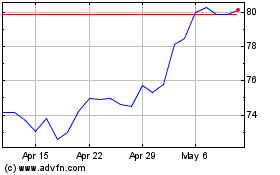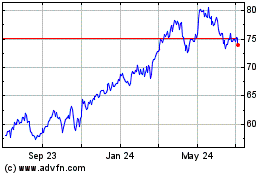By Leslie Scism
American International Group Inc. uses one of the industry's
leading algorithmic models to determine how much companies should
pay for insurance. It just doesn't trust what the model computes on
its own.
As part of an approach it started rolling out last year, the
global insurance conglomerate pairs its models with human
underwriters. The approach reflects the company's belief that human
judgment is still needed in sizing up most of the midsize to large
businesses that it insures. AIG even has a nickname for
underwriters who keep the same price as the model every time: "flat
liners."
Insurance companies such as AIG are among the original financial
quants, from tracking ships to derive marine-insurance prices to
using quantitative analysis to determine the likelihood of
automobiles crashing, hurricanes wiping out beach towns and juries
finding doctors liable for malpractice.
Now, promising new techniques including algorithms can help
carriers tap into a growing array of detail to price risk: sensors
in factories, devices worn by construction workers,
employee-sentiment data and satellite imagery, to name a few.
AIG's commercial-insurance unit alone pays $75 million each
business day in claims. The insurer is a major seller of policies
that cover such diverse things as the cost of injured workers;
wrecks of corporate-owned vehicles; fire and other damage to
premises; cyber hacking, contaminated products and offshore
drilling rigs.
When an underwriter "turns off his or her brain, we're done,"
said Madhu Tadikonda, chief underwriter for AIG's commercial unit.
"The models by themselves are not perfect" for many of the risks
posed by policyholders.
Still, in an example of how data analysis can make a difference,
AIG recently informed a hotel client that it should mop its floors
at 3 a.m. to reduce slips and falls. It also has advised clients
that employees with carpel tunnel syndrome are at high risk of
repeat injuries, so the customary push to quickly get a person back
on the job can backfire.
Underwriters such as Matthew Lebron call on business clients
keeping an eye out for characteristics that distinguish them, "so I
can make the judgment call to go upward or downward" from the
computer-generated average price. Among questions he asks: Is a
business up to snuff with industry safety standards? Is it working
with AIG's loss-control program to try to minimize the risk of
claims?
"There's definitely an element of human touch," said Brett
Herrman, who works as a "technical underwriter" at AIG, running the
model when colleagues go out in the field. "We're diving in on
detail and collaborating as a team."
The need to pair with humans hasn't stopped the arms race for
data and innovative technology in the industry.
In a recent survey by consulting firm Accenture, 37% of about
550 insurance executives said they plan to invest "extensively" in
machine learning over the next three years, and another 44%
anticipate "moderate" investment.
More "insurers are doubling down on their efforts to combine
their human intelligence with the fast, effective decision-making
capabilities of machine intelligence," said John Cusano,
Accenture's global head of insurance.
Progressive Corp. is among the elite few with successes in hand.
Back in the 1990s, the car insurer identified correlations between
credit histories and claims, testing a hypothesis that financially
responsible people are more cautious drivers. Previously, insurers
relied on underwriters to place applicants within broad categories
such as age, gender and car type.
More recently, insurers have begun using algorithms to issue
policies to small to midsize businesses online. They can draw on
data such as construction features of a business's premises,
proximity to fire hydrants and code violations.
Berkshire Hathaway Inc. has such an offering, and last year AIG
joined with Hamilton Insurance Group Ltd. and an affiliate of
quantitative hedge fund Two Sigma Investments LP in an online
venture.
Analysts and executives say algorithms work well for
standardized policies, such as for homes, cars and small
businesses. Data scientists can feed millions of claims into
computers to find patterns, and the risks are similar enough that a
premium rate spit out by the model can be trusted.
But risk is increasingly nuanced the bigger the business.
Policies often are tailored, and claims infrequent, so there is
less information to work with. And, mistakes can be costly.
Former AIG Chief Executive Peter Hancock has been one of the
industry's biggest champions of data analytics, frequently
narrating how, about six years ago, researchers at Johns Hopkins
Bloomberg School of Public Health studied millions of AIG's old
workers' compensation medical records and identified problems from
overuse of opiates. Now, AIG reaches out to a patient's medical
provider early to suggest nonaddictive treatment.
Starting in 2012, Mr. Hancock hired a "Chief Science Officer"
and 150 science-minded people, many with Ph.D.s. They sent hundreds
of boxes containing details of old claims to an outside source to
digitize to allow data mining. Mr. Hancock was succeeded last week
by Brian Duperreault, formerly Hamilton's CEO and another leading
proponent of data science. As part of his hiring, AIG said it would
work with Two Sigma to develop an estimated $250 million "next
generation insurance platform" to accelerate its use of data
science.
Sitting at his desk with photographs from Apple Inc.'s 1990s'
"Think Different" marketing campaign on the wall behind him, Mr.
Tadikonda said he prefers to see many policies priced both above
and below the model-driven average price.
He said there are times the modeling team will call an
underwriter and say, "Hey, what's going on? You are down 25%"
against what the model recommends. His favorite response from an
underwriter: "You're damn right."
Write to Leslie Scism at leslie.scism@wsj.com
(END) Dow Jones Newswires
May 23, 2017 11:11 ET (15:11 GMT)
Copyright (c) 2017 Dow Jones & Company, Inc.
American (NYSE:AIG)
Historical Stock Chart
From Mar 2024 to Apr 2024

American (NYSE:AIG)
Historical Stock Chart
From Apr 2023 to Apr 2024
